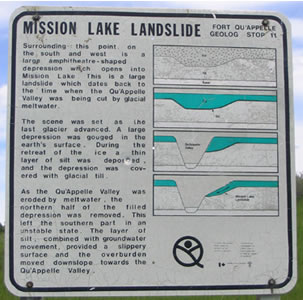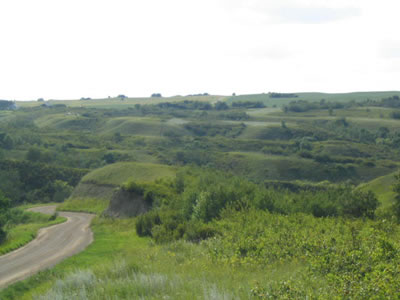
 |
|
Qu'Appelle Valley Geolog Stop 11
- Mission Lake Landslide
[ Previous Stop ] [ Next Stop ] 
Beware when arriving at Stop 11 - it's a hunting ground! The sign for stop 11 is located at the top of a hill covered by wildflowers and small groups of trees. This area is a favourite spot for deer and other animals, as well as birds and insects. Upon entering the grounds many common plant species are evident. Grasses are especially obvious, as the area is frequently mowed for hay. Crested wheat grass is the dominant grass here - it is not native to Saskatchewan, but was introduced during the later years of the Great Depression. Crested wheat grass is a plant species that will take over an area and prevent other species from establishing. Geology During the last ice age, a depression was formed in the area of Stop 11 in one of the layers of till deposited by previous glaciations. After the last ice age retreated it deposited large amounts of till at the upper ends of the depression, but very little in the middle. Then, as the ice melted and the water eroded what is now the Qu'Appelle Valley, it eroded a gully right through the middle of this depression.
As we learned about landslides at Stop 5, land that appears to be stable often is constantly shifting. With the formation of a deep gully through the weakest point of the till layer deposited in the last ice age, the heavier upper ends were unable to support themselves. They began to collapse inwards, shifting sand and gravel downward into the gully and filling it up. Now the landslide has settled somewhat and there is a lot of tree and small plant growth in the gully of Stop 11, but the effects of the landslide are still visible in the ridges and land formations along the sides of the hills.

Plant species found at stop 11:
|
Page last updated on
2004-10-08 |